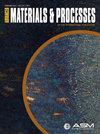电机增材制造
IF 0.8
4区 材料科学
Q4 MATERIALS SCIENCE, MULTIDISCIPLINARY
引用次数: 0
摘要
与传统工艺相比,使用添加剂方法制造电动机具有提高效率、减轻重量和可定制性的潜在优势。本文描述了增材制造电机在制造、材料开发和设计方面的一些关键发展和挑战。本文章由计算机程序翻译,如有差异,请以英文原文为准。
Additive Manufacturing of Electric Motors
Abstract The manufacture of electric motors using additive methods offers potential advantages of increased efficiency, weight reduction, and customizability over traditional processes. This article describes some key developments and challenges related to additively manufactured electric motors in terms of manufacturing, materials development, and design.
求助全文
通过发布文献求助,成功后即可免费获取论文全文。
去求助
来源期刊

Advanced Materials & Processes
工程技术-材料科学:综合
CiteScore
0.40
自引率
0.00%
发文量
0
审稿时长
>12 weeks
期刊介绍:
Advanced Materials & Processes (AM&P) is the flagship publication from ASM International.
 求助内容:
求助内容: 应助结果提醒方式:
应助结果提醒方式:


